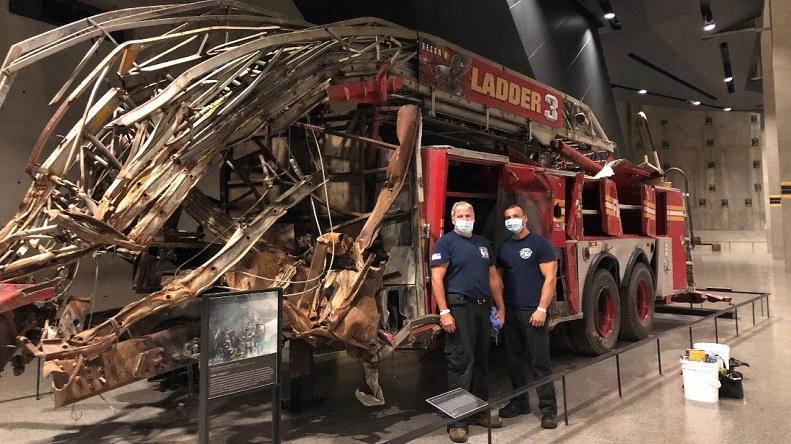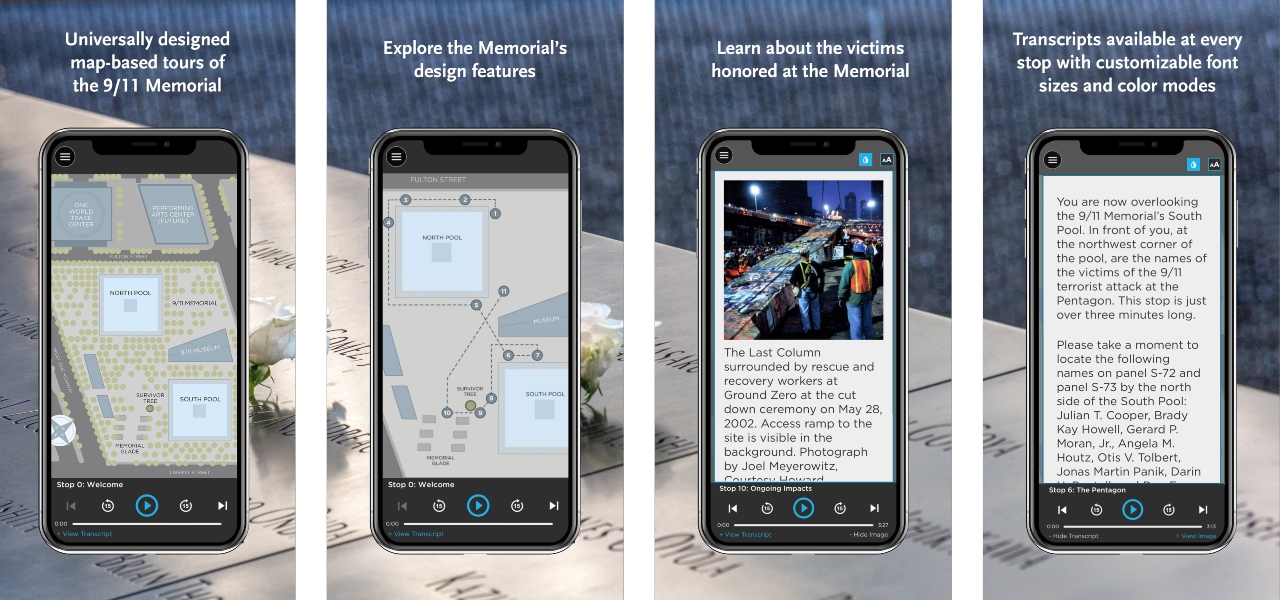Make a donation to the museum
Conservation Efforts for Emergency Vehicles in the 9/11 Memorial Museum
Conservation Efforts for Emergency Vehicles in the 9/11 Memorial Museum

On the morning of September 11, 2001, EMS Battalion 17 Emergency Medical Technicians Benjamin Badillo and Edward Martinez were on an assignment in the Bronx when they were dispatched to the World Trade Center in their FDNY ambulance. Arriving on scene, they parked at West and Vesey Street, near a fleet of other emergency vehicles. These included the rear mount ladder truck for FDNY Ladder Company 3, led by its highly decorated captain, Patrick John Brown, and FDNY Engine 21, which was dispatched to the World Trade Center after hijacked Flight 175 struck the South Tower. Engine 21’s crew, led by Captain William F. Burke Jr., parked underneath a pedestrian overpass on Vesey Street before entering the North Tower for their ascent to its higher floors.
Each of these vehicles—damaged in the collapse of the World Trade Center and now on display in the 9/11 Memorial & Museum—is emblematic of the professionalism and sacrifice of 9/11 first responders. While these large-scale objects are conduits for stories that help shape our understanding of this historic day, they are also unique physical artifacts with distinct properties and histories. In the aftermath of the World Trade Center’s destruction, each vehicle was recovered from Ground Zero, assessed and processed at the Fresh Kills forensic facility, and then stored for safekeeping at JFK International Airport’s Hangar 17. Almost ten years after 9/11, they journeyed back to the World Trade Center site where they were readied for display. Now in their permanent home at the 9/11 Memorial & Museum, each requires ongoing maintenance and conservation.

Photograph by Richard DuBois, Here is New York Collection, New-York Historical Society, Gift of Here is New York
In the aftermath of September 11, debris from the World Trade Center site was sent to the Fresh Kills Landfill on Staten Island. Toward the end of the recovery operation in the summer 2002, the FDNY’s Battalion 17 ambulance, Ladder 3, and Engine 21 were transferred to Hangar 17 at JFK Airport with a vast assortment of World Trade Center wreckage: structural steel, other damaged vehicles, and architectural remnants from the Austin J. Tobin Plaza and Concourse-level retail shops. Operated by the Port Authority of New York and New Jersey (PANYNJ), the Hangar 17 facility was tasked with decontaminating and conserving select World Trade Center artifacts. Hangar 17 became the temporary storage space for large-scale artifacts until a permanent plan emerged for their future memorial, educational, and exhibition uses. To that end, the PANYNJ, in conversation with their conservation consultant, Art Preservation Services, inventoried, assessed, and established storage and handling protocols for the artifacts, many in vulnerable condition.

FDNY Ambulance and FDNY Ladder 3 at Hangar 17. Photo by Museum staff.
Museum professionals from local, state, and federal museums and historical societies visited both Fresh Kills and Hangar 17 to identify visually impactful artifacts and begin the exhaustive task of researching their history and connection to 9/11 responders and survivors. When the National September 11 Memorial & Museum project launched in 2006, its formative curatorial team conducted additional research and engaged in conversation with the firefighters, EMTs, and others connected to the artifacts. In time, roughly 415 objects would be transferred to the Museum from the Port Authority of New York and New Jersey, among them: the FDNY Ambulance, Ladder 3, and Engine 21.
The vehicles selected for display in the Museum were inspected and cleared by the Office of Chief Medical Examiner. They also underwent abatement to remove any potentially harmful dust particles attributed to the collapse of the World Trade Center. Additionally, in December 2010, all fluids such as engine, transmission, diesel, and hydraulic, were drained from the vehicles for safety reasons and as part of the decommissioning protocol for FDNY vehicles.
In July 2011, the FDNY vehicles made a ceremonial return to the World Trade Center site, accompanied by an honor guard that escorted them from Hangar 17 to the Museum. Before leaving the airport, each vehicle was wrapped in a protective covering and draped with an American flag. At the Memorial plaza, FDNY officials, responders, and family members watched as a crane gently lowered each vehicle through a hatch on the Memorial plaza into the Museum, 70 feet below street level, to bedrock. Presided over by FDNY chaplains and its Ceremonial Unit, these solemn occasions were alternately described as a homecoming and a funeral. During the ceremony for Ladder 3, bagpipers played the national anthem while the replacement 3 truck raised its ladder in salute.

FDNY Ladder 3 being lowered into Museum. Photo by Amy Dreher.

FDNY ambulance being lowered into the Museum. Photo by Amy Dreher.

FDNY Ladder Company 3 truck and its replacement on the Memorial plaza. Photo by Museum Staff.
The FDNY vehicles were among the first of 17 very large artifacts to be lowered into the Museum while it was still under construction. These artifacts were all staged in Foundation Hall, awaiting final installation, when Superstorm Sandy hit the New York area on October 29, 2012. Sandy brought massive storm surge and flooding to the Metro region and especially to lower Manhattan, including the 9/11 Memorial & Museum. The Museum “cavity” at bedrock flooded with approximately 7 feet of water, which entered the space through an unfinished security-screening facility immediately south of the Museum site.

Photo of Foundation Hall after Superstorm Sandy. Photo by Amy Dreher.
Although the vehicles were securely wrapped in plastic sheeting, the level of flooding was such that they were completely inundated with brackish water. In a matter of days, the storm waters were pumped out of the Museum, enabling conservators to quickly begin their work of cleaning and drying the vehicles. Time was of the essence to prevent the formation of mold and rust. The trucks were cleaned with a biodegradable cleanser to remove any microbial soiling. They were next steam cleaned to remove any remaining salt water, a process that expedited the evaporation of surface moisture to avoid the onset of rusting. Once the cleaning was completed, the vehicles were moved into their present locations within the exhibition experience, ready for the 9/11 Memorial & Museum’s May 2014 opening.
Staff from the Museum’s Collections department routinely reviews the condition of each vehicle on permanent display, monitoring tires for signs of embrittling, checking areas of flaking paint for stability, and ensuring that dust accumulation is kept at bay. Dust is problematic because it is hygroscopic, meaning it attracts water from the air. Having something that attracts water which also sits on the surface of these metal trucks presents a continuous risk of corrosion. In fall 2019, the department’s conservation team began to notice some strange crystals forming on the underside of the vehicles and observed fluids beginning to drip onto the floor underneath the vehicles. The liquid residues were particularly concerning as fluids had been drained as part of the initial vehicle decommissioning process in 2010.
It was suspected that these crystalline formations and fluids were remnant flood waters from Superstorm Sandy, trapped in the vehicles’ mechanical systems, finally migrating out of the interstices. The combination of water and metal led to corrosion and small amounts of metal loss over time, enabling the fluids to escape. When the brackish water evaporated, salt crystals formed on the surface of the metal.
The team monitoring the conditions lacked the mechanical expertise to determine where the water was trapped. During winter 2019, a plan was made to coordinate with the experts at FDNY Fleet Services and invite their diagnostic collaboration in developing a plan to rid the affected vehicles of their Superstorm Sandy legacy.
After an initial assessment, Fleet Services returned to the Museum over the summer, when the Museum was still closed to visitors due to the pandemic. They brought with them a full team including Assistant Fire Commissioner Mark Aronberg, Executive Director of Fleet Operations Andy Diamond, as well as Emergency Crew Mechanics Roy Caulkin and Nick Saccas. During their examination of Ladder 3 it was discovered that the rear axles had not been effectively drained in the aftermath of Superstorm Sandy. Remarkably, they drained away approximately 5 gallons of water from the axles. They also managed to remove an old oil filter from the Ambulance and fit it with a replacement that could absorb any additional fluids.
Now that all the FDNY vehicles have been reassessed by Fleet Services, the conservation team is confident the crystal growths and fluid leakage will be things of the past. We are extremely grateful to the extraordinary staff at Fleet Services who have helped the 9/11 Memorial & Museum care for these poignant vehicles in the past and who continue to share their time and unparalleled knowledge with us so generously at every turn.

By Maureen Merrigan, Assistant Conservator, and Christina Chavez, Collections Management Assistant, 9/11 Memorial & Museum
Previous Post
Remembering Rabbi Jonathan Sacks, Who Extolled the Possibilities of Interfaith Understanding in a 2016 Visit to the 9/11 Memorial Museum
Rabbi Jonathan Sacks, who died last Saturday, appeared at the 9/11 Memorial Museum in April 2016, as part of the Museum's continuing series of discussion programs focused on the possibilities of interfaith understanding.
Next Post
9/11 Memorial Launches Audio Guide App

The 9/11 Memorial & Museum launched a new app to teach Memorial visitors and those at home about the events of 9/11, the lives of the victims of the attacks, and the design of the Memorial.